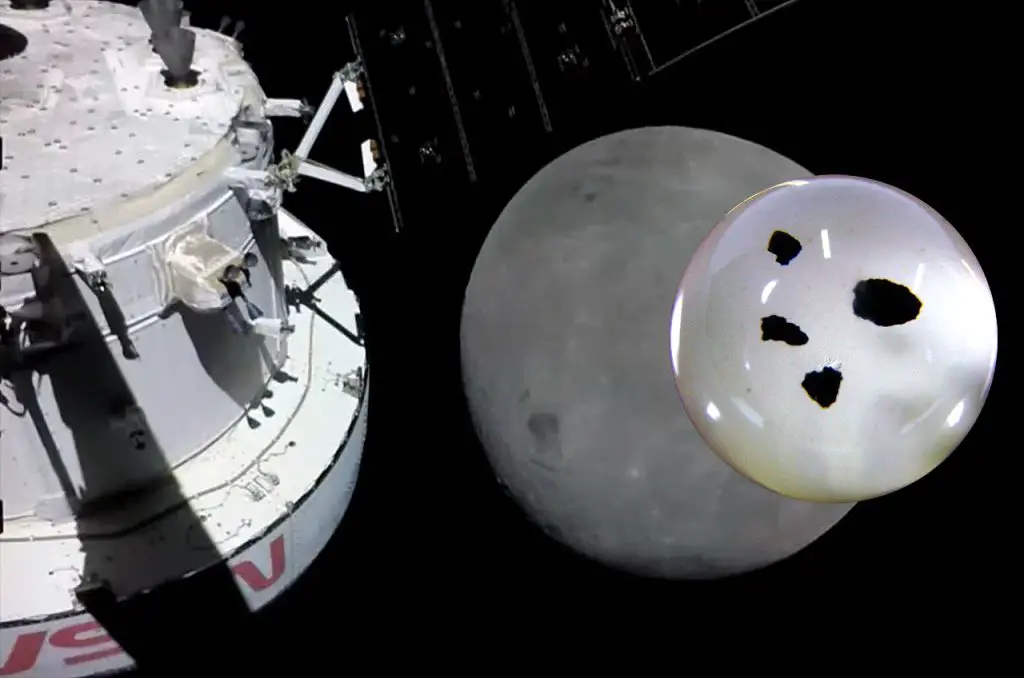Before Artemis 1 spacecraft was launched to visit the moon, NASA officials added four small pieces of on the Orion Spacecraft. These small moon rocks were returned to Earth as part of the lunar sample by Apollo Astronauts Neil Armstrong, Buzz Aldrin, and Michael Collins. On Monday, November 21, NASA’s Orion Spacecraft made its close approach of about 80 miles (130 kilometers) to the moon.
This implies that around 50 years after the Apollo 11 astronauts collected these rock samples, the NASA Orion spacecraft fly across the moon with the same rock samples. These lunar samples were kept inside a button called a small lucite bubble. NASA conducted the flyby mission to use the moon’s gravitational force in directing the spacecraft to make a successful entry into a lunar distant retrograde orbit.
“For Apollo 11, we had the goodwill samples. These were individual, greater than 2-millimeter [0.08-inch] fragments separated out of the biggest of soil collected on Apollo 11 and they were gifted to every country and every state. We made more than we handed out, we had four or five leftovers. This is one of the leftovers,” Ryan Zeigler, Apollo sample curator at the Johnson Space Center in Houston, told collectSPACE.com.
This statement implies that only a small percentage of the lunar samples were taken from the original sample returned during Apollo 11 moon landing mission and embedded on the Artemis I spacecraft. Specifically, only about the 0.002 ounces (0.05 grams) of Apollo 11 moon dust kept inside the button is a small percentage of the 842 pounds (382 kilograms) of lunar material returned by the Apollo 11 astronauts.
However, If NASA succeeds in its Artemis space program, the agency will likely establish a sustainable human presence on the moon. This implies that more rock samples will be returned to Earth from the moon increasing the percentage of rocks humans have ever collected from our closest celestial neighbor. NASA has previously launched rock samples into space during the Tranquility Base first flew aboard the Exploration Flight Test-1 (EFT-1) in 2014. This implies that the Artemis 1 mission is the second time NASA is launching these samples inside a button into space.
Orion Going Beyond the Moon
On Sunday, November 20, the Orion Spacecraft moved into the lunar sphere of influence at exactly 2:09 p.m. EST (1909 GMT). Keep in mind that the spacecraft was able to reach this milestone within five days of commencing its 25-day mission around the moon and beyond, before making its way back to the Earth.
On Monday, November 21, at 7:44 a.m. EST (1244 GMT) NASA’s Orion conducted a trajectory correction burn overnight before firing its orbital maneuvering system engine for about two minutes and thirty seconds to accelerate into the fly. The spacecraft made its closest approach to the moon in the next 11 minutes and 30 seconds.
“We will be passing over some of the Apollo landing sites,” Jeff Radigan, NASA’s Artemis 1 flight director, said at a pre-flyby press briefing in response to a question from collectSPACE. “We’ll be going over the Apollo 11, 12, and 14 sites, or close to them. Unfortunately, they are going to be in the darkness, they will not be sunlit, so we won’t get very good videos of them. But we will definitely be close to history when we do the power flyby.”
However, NASA has earlier anticipated losing communication signals with the Orion spacecraft at some point during the mission. As the spacecraft makes its way behind the moon, technicians monitoring the spacecraft lost its communication signal for about 34 minutes starting at 7:26 a.m. EST (1226 GMT).
But after 34 minutes the Orion spacecraft crossed from the far side of the moon making it possible for the Goldstone ground station in southern California, part of the Deep Space Network, to reacquire its signal once again.
NASA is expecting the Orion spacecraft to move into its distant retrograde orbit on Friday (Nov. 25). On November 26, the spacecraft is expected to cross the distance record set during the Apollo 13 mission in 1970. On November 28, the spacecraft will reach its maximum distance from Earth, covering about 268,554 miles (432,194 km) away from our home planet.
While making its way back to the Earth, the Orion spacecraft and its lunar rock samples will perform another close flyby of the moon on December 5. NASA is expecting to end the Artemis I mission as the Orion Spacecraft splashdown in the Pacific Ocean on December 11.
Conclusion
The Artemis 1 mission is already making progress that will enable NASA to prepare for its Artemis 2 mission in 2024 and Artemis 3 mission in 2025. If all goes as planned, NASA’s Artemis 4 mission will be coming up in 2027. We should all be hopeful about the future of humans returning to the moon starting from the Artemis space program. What do you think about this closest approach to the moon made by Orion Spacecraft with Lunar Rock Samples on board?





If I can keep my health I surely want to book for the 2026 flight-Just to be able to take a picture back to earth of my own project’s reflective plate
wow, this is super cool. You will surely be healthy to have the best moment in life